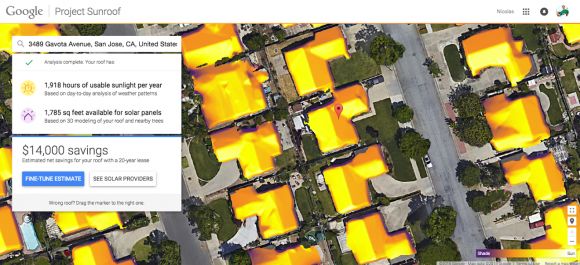Google Earth allows users to explore the far reaches of the globe from behind a computer screen with just a few clicks. Now, the same data that powers Google Earth will allow homeowners to explore their own rooftops to determine if they're suitable for solar panels.
Google’s new online tool called "Project Sunroof” launched today in the San Francisco Bay Area, Fresno and the greater Boston area. It uses high-resolution aerial imagery -- the same imagery used by Google Earth -- to help calculate a roof’s solar energy potential. The company calls it “a kind of treasure map of solar energy.”
“Millions of people already search Google every year to learn more about solar power. We’re big believers in clean energy ourselves, and Project Sunroof is a way for us to do even more to help people explore the value of going solar,” Barry Fischer, a spokesperson for Google, wrote in an email. “We’re excited to use our expertise in maps, machine learning, and high-resolution aerial data from Google Earth to make it happen."
To use Project Sunroof, anyone living in one of the test areas simply needs to enter their address. The program then figures out how much sunlight hits that rooftop throughout the year, taking into account factors like shade, roof orientation and local weather patterns. Potential solar customers can also enter the amount of their typical electric bill for more customized results.
All of this information is combined to create an estimate for how much a given household could potentially save by going solar. The site also helps customers connect with local solar providers, including NRG Home Solar, Vivint Solar and SunEdison.

Google has long been a supporter of low-carbon energy. It is currently the largest corporate purchaser of renewable power on the planet, and recently announced plans to triple those purchases over the next decade as part of a larger pledge to act on climate change in partnership with the White House.
In 2011, Google dropped its R&D initiative, called RE<C, which was intended to allow emerging solar, wind and geothermal technologies to rival the economics of coal. In its place, the company has taken a more deployment-heavy approach. Google has committed more than $2 billion to supporting clean energy projects around the world, including Africa’s largest solar power plant. The company has also been a champion of clean energy policy in the U.S. and abroad.
The tech giant also has a specific interest in residential solar, having made previous investments in Clean Power Finance, SunPower and SolarCity (Google committed $300 million to a SolarCity fund in February). The launch of Project Sunroof continues that trend.
The pilot is the result of a "20 percent project" -- a program that gives Google employees one day a week to work on side projects -- led by software engineer and solar owner Carl Elkin, out of Google’s Cambridge, Mass. office. Learn more about the project in this video:



